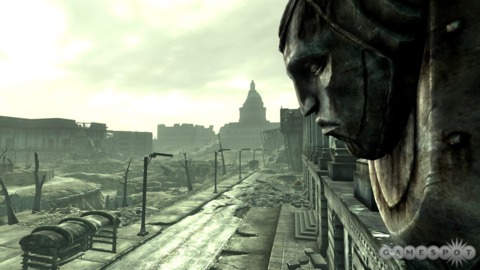DICE 2009: Day Two Wrap-Up
What do you get when a bunch of groggy, half hung-over game developers, publishers and press come together? Why it's DICE Day 2, of course! Lots of tired folks shuffling around the floor of the Red Rock Casino and Hotel, looking for whatever food they could get their hands on and then filing...
What do you get when a bunch of groggy, half hung-over game developers, publishers and press come together? Why it's DICE Day 2, of course! Lots of tired folks shuffling around the floor of the Red Rock Casino and Hotel, looking for whatever food they could get their hands on and then filing into the Summerlin ballroom to watch a set of session that, ironically, were a bit more lively than yesterday's.
Top of the heap was Bethesda's Todd Howard's amusing, inspiring and LOLcats-packed presentation on the making of Fallout 3. During his presentation, Howard compared game development to the action of leaping over babies (complete with photograph); a delicate, demanding, and dangerous task and one where the slightest mistake can result in catastrophe. Much like Bruce Shelley's Ensemble post-mortem from Thursday, Howard stressed the importance of a tight-knit team of developers working together, putting special emphasis on maintaining a "low a#@hole quotient" within the team.
Media Molecule's Alex Evans followed Howard on stage, and appeared more than a bit overwhelmed by the tremendous success of MM's LittleBigPlanet at the previous nights' AIAS Awards. During his talk, Evans discussed the process or reinvention and iteration that was involved in the creation of LBP and its in-depth user-creation tools. Evans pointed out that, while user-generated content is nothing new to videogames--the big struggle for Media Molecule was to find where LittleBigPlanet's tools fit into the UGC spectrum. Eventually the team landed on the idea of "being playful"--in other words making the creation of games and levels in LBP just as enjoyable as playing the game itself.
Beyond the most cursory of glances at the style-maker in the Sims 3, there was much in the way of new gameplay to check out during today's sessions. However, Nintendo's senior director of project development Tom Prata did give folks a look at an upcoming DS Ware application called Moving Memo for the upcoming Nintendo DSi. Already out in Japan, this cool-looking little app will let you do everything from write and save memos to create animations from simple drawings you scribble on your touchscreen, add sound to it and create your own little miniature animated movies. You can even take video (albeit a grainy black-and-white) using the DSi's camera and then draw on top of your video for some pretty funny effects. No price or full reveal date was announced but I'd guess it would be released some time around the DSi's retail debut in April.
More Day 2 Tidbits:
- According to Media Molecule's Alex Evans, the development studio that created LittleBigPlanet was originally known as brainfluff.
- From Todd Howard: Fallout 3 contains more than one million words and 50 hours of recorded dialogue. And that's presumably not counting the DLC content. Impressively, all of that content was managed by just two developers.
- In his session, Alex Evans once again showed off the first working demos of what would eventually become LittleBigPlanet. At that time, the game was known as Craftworld and the demo didn't focus on the user-generated content or the rich art style. Instead the demo was meant to show off the expressive nature of the game's controls. At that point, Sackboy wasn't even a sack; just a boxy looking, primary colored, geometric approximation.
- According to Kyle Gabler, one half of 2D Boy (the development duo behind last year's World of Goo), the game cost $10,000 to make.
- The creation tools in LittleBigPlanet went through at least three major revisions, according to Alex Evans. At first, creation was done with in-game objects (such a fire hose that might spray water or some other substance, or a hair dryer that would melt down objects). The devs scrapped that idea and moved to a cross-media bar-type tool before settling down with the "stamp" concept for creation that they ended up with.
- During his session, Raven's co-founder Brian Raffel related a story regarding the early days of the Madison, Wisconsin-based development studio. When studio execs began searching for a strategic partner, representatives from one of the first companies to approach Raven decided to arrive in Madison--presumably looking to fit in with the locals--wearing flannel shirts, down vests, and blue jeans. Needless to say, they didn't get the deal.
Got a news tip or want to contact us directly? Email news@gamespot.com

Join the conversation